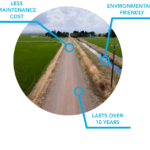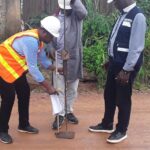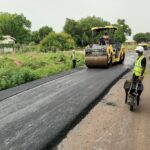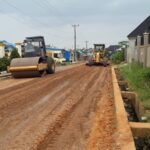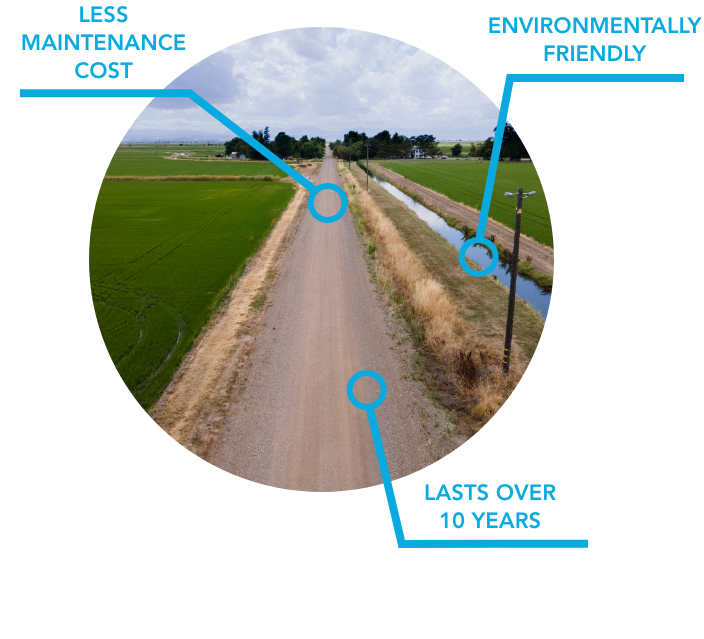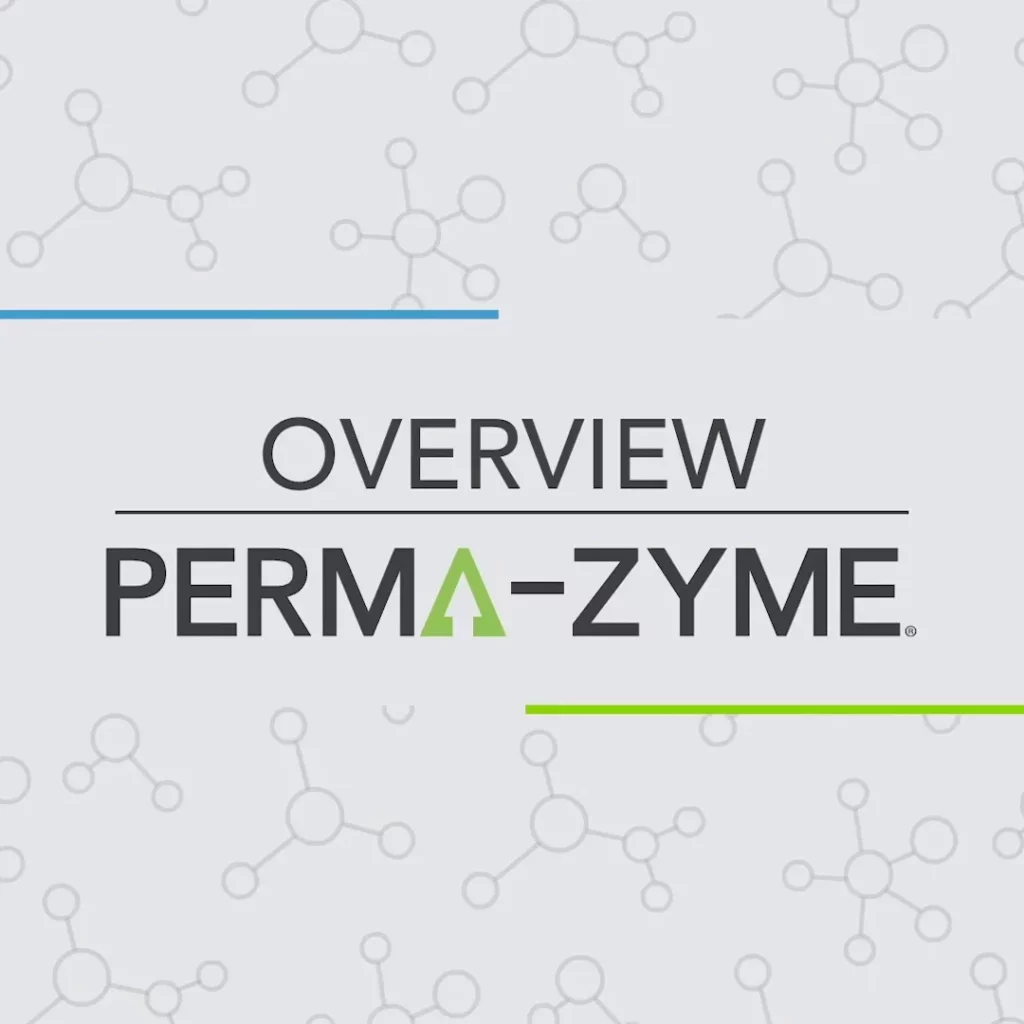
FAQ
While the amount of water needed will vary from application to application depending on the soil and optimum moisture, the amount of Perma-Zyme will never change.
For example, if the road constructed is a two lane (7.3metres wide) 1kilometre long (7,300 sq.m) road and will be 150mm deep the application will require approximately 2,440 cubic yards of soil and 38 litres of Perma-Zyme
Perma-Zyme’s best feature is that it is extremely versatile and works with a wide range of soils. When using Perma-Zyme the soil should be comprised of 15-20% cohesive fines. It is important to have a wide variety of material sizes in the soil to increase shear strength and internal friction which increases the load bearing capacity of the soil.
Perma-Zyme is used mostly in applications in which the soil is comprised of 15-20% cohesive fines but has been used in applications outside of the targeted range and performed well. Upon beginning any application of Perma-Zyme it is recommended that test is performed to ensure Perma-Zyme will yield the proper results.
To have your soil assessed for free, contact us.
Yes, Perma-Zyme is the perfect foundation for an asphalt or chip seal construction road. When using Perma-Zyme with a chip seal application, apply Perma-Zyme as detailed in the normal instructions and allow 72 hours to fully cure. Prior to the chip seal application spray a small amount of Perma-Zyme diluted with water (approximately 1000:1) to allow the chip seal application to bond to the base layer.
A typical application for Perma-Zyme consists of 5 steps:
Grind or shred current road and soil until thoroughly mixed and a sieve test produces 15-20% cohesive fines.
Spray Perma-Zyme and water on soil until optimum moisture is achieved. Mix soil consistently by grading the soil from side to side at different depths.
Grade the soil to the desired road dimensions and path
Using a compactor, compact the soil in 3-6” lifts depending on soil and application until desired density is achieved.
Allow 72 hours for Perma-Zyme to fully cure.
For more information request our training videos here.
Having the proper tools for the job is extremely important to ensure your Perma-Zyme application will succeed. Substrata recommends the following equipment:
Water tuck
Motor Grader (Caterpillar 140H or equivalent)
Padfoot (Sheepsfoot) Compactor (NOTE: Not required but very beneficial to have)
Drum Compacto
The life span of a Perma-Zyme road depends on many factors including traffic, weather, water drainage, and paved vs. unpaved. Roads with a dirt surface typically see a lifespan of 8-12 years while paved roads see a lifespan in excess of 20 years.
Yes, for dirt road construction Perma-Zyme diluted in water can be sprayed on the soil to deactivate the soil’s cementation and allow the soil to be moved and manipulated. After achieving the desired shape and form of soil allow 72 hours for the soil to fully cure.
When chip seal has been used, traditional chip seal repair procedures can be used.
Perma-Zyme’s most unique aspect is that it allows the native soil to be used and does not require transportation of any soil or rock for the base layer of the road construction. Because Perma-Zyme can use the native soil the construction costs will be greatly decreased and will save time on the construction phase. Because of Perma-Zyme’s unique cementation effect it produces a strong and robust base layer that will lead to a long-lasting road.
Curing time is seven days, but curing continues for 28 days. Roads however
harden right away.
During construction, and immediately after. The more traffic the better the com-
paction.
When you go over the optimum moisture content during construction, or heavy
rain during or just after construction. This is not a problem as it usually cures it-self.
Two things can be done. On heavy traffic roads, it will correct itself or given time
with no problems, or 20mm of the surface can be re-worked, as you have up to
seven days curing time.
This will depend on the soil and gravel being treated, but anywhere from 100% to
1200% improvement can be gained. Independent. empirical evidence is avail-
able.
Yes, but PermaZyme must be used to patch or resurface the treated road. Please
ask for a maintenance guide
Good work practices are essential to good road construction. The job should only
be carried out by professionals. Drainage and profile errors are nothing to do
with the efficacy of the product. As a result, puddling will occur, which will under-
mine the road. Good drainage and proper profiles are a must.
No, brackish water and seawater have been used successfully, but the better the
water supply, the less problems will occur.
PermaZyme will allow the use of both to be cut by half, and a massive increase in
CBR’s can be gained along with huge savings in material costs.
Using low quality insitu soils and gravels to construct low cost, low maintenance
roads. Saving valuable resources in the construction of highways is the result.
With today’s budgets, cost savings are vital.
There are three main elements: 1] sophisticated surfactants that allow the other
two elements to penetrate the clay based soils, and make it workable. 2] electro-
lytes that change the cation exchange of the clay platelets. 3] enzymes that ce-
ment together the clay platelets within the sands, silts and gravels.
No, you lose the benefit of the cation exchange, as it will be reversed and you
will end up with a lower strength.
PermaZyme should not be applied in rainy conditions.
The soil used is low in clay content, and high in silt fines. A proportional mix de-sign should have been used. Remember, clay is the binder and that PermaZyme
only works on the clay particles within a soil / gravel mix. Normally dust disappears shortly after a proper application.
This has do with good work practices during construction, which include: rain
during construction, correct drainage, finishing and profile.
The fact is, that PermaZyme is 82% biodegraded in 14 days, and you have seven
days that you can store & windrow the treated soil prior to compaction after full compaction, the surface will be tight and will require re-application of PermaZyme at 10,000 to 1 to soften the surface to prepare for a thin, clean layer of small aggregate to act as a wear coat.
This action is employed where the soils are mainly fines and the soil lacks gravel
and grading. It is recommended on hills as a precaution, should it rain within
seven days of construction. If the grading of the soil is ideal, this is perceived as another added cost to low cost roads.and that it is not necessary on a flat road. Yet, we are now recommending that it
be done on all projects. Why?
PermaZyme is shipped abroad in a highly concentrated form, which is fresh from the factory. It should be shaken a little prior to use. There is nothing wrong with the
product, even if not shaken, for it is still at full strength. The sediment is a resut of the
culture and fermentation.
